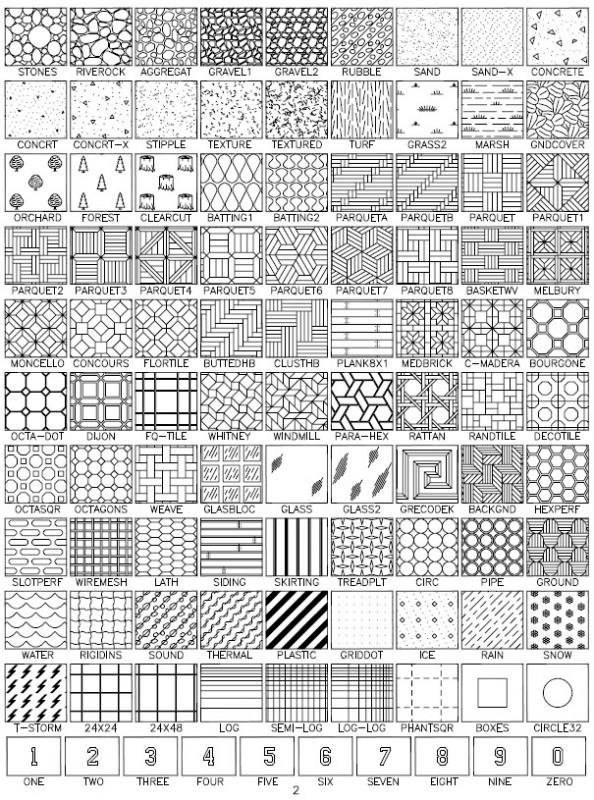

Move out to your Custom tab and your custom hatch patterns will be displayed in a list as shown. Select T for settings once again to bring up our dialog box. Move back out to your command line and type Hatch or select Hatch from the Draw Panel on the Ribbon. Hit OK and Apply and get out of the dialog box.

Simply select the Move Up button and move to the top of the Support Search File Path (just in case you have other custom files that are loaded ahead of this file). It will be added to the bottom of your list. You will now browse out to your Custom hatch folder and add it to the path.

Within this dialog select the files tab and pull out the Support File Search Path and select the Add button as shown. In AutoCAD type Options at the command prompt or right-click in the command area to bring up the Options dialog box. The next thing we need to do is add that folder to our Support Search Path in AutoCAD. We then placed all of our hatch patterns that we downloaded to that folder. Move out to your local C drive (or network folder) and create a Hatch folder, in this example we named the folder CustomHatch. Notice how there is nothing in the image to the right under the custom tab. Let’s add some custom hatch patterns to this tab. Selecting the custom tab will bring up the same dialog box with nothing in there as shown highlighted in yellow in the image on the right. Next select the ellipses as shown next to the pattern name to bring up Hatch Pattern Palette with a Custom tab shown.Īfter selecting the ellipses you will see the Hatch Pattern Palette as shown on the left portion of the image below. This will bring up the Hatch and Gradient dialog box as shown below. You are asking “Sam, what custom tab?” Select Hatch on the Ribbon (or type Hatch at the command prompt) then T for Settings. Let us now add some extra patterns to the custom tab. You can give your patterns a name with the format *MYNAME, DESCRIPTION followed by the pattern as shown below in the EARTH example.Example of the Earth You can edit the default PAT files that are installed with AutoCAD by using Notepad and adding your custom hatch pattern data at the end of the file. Hatch patterns are stored in a file named ACAD.PAT or ACADISO.PAT. Recently I have had several people ask me about the custom hatch pattern tab in AutoCAD and how to populate that tab with your custom patterns. Please wait a few minutes and refresh this page.Let’s talk Hatch Pattens. AutoLISP: Make and Save Custom Hatch PatternĮrror: Twitter did not respond.Use Align Space to Easily Align A Viewport View.Change the "Standard" Font in AutoCAD Template.So if you decide to modify the boundary, it will not be “associative” Notice that after the hatch has been applied that it is now a “group” and not a true hatch. Specify an option : Pick inside of enclosed area to apply the hatch.Is the placement of this BLOCK acceptable?.(The next few prompts are similar to inserting a block) Select the block name from the “Super Hatch – Insert” dialog box and click “OK”.Select “Block” from the Super Hatch menu.The prompts for using a block are shown above and are listed below:
#HOW TO ADD HATCH PATTERNS TO AUTOCAD 2013 HOW TO#
There is also a great video by Lynn Allen demonstrating how to use SUPERHATCH and applying images as a hatch Super Tip: One of my favorite uses of this tool is that you can make a hatch pattern out of curved objects!!! (Note: there are many options and ways of using this tool so I would suggest looking into the various options by hitting the F1 button after launching the tool) Also found on the Express Tools tab > Draw panel > Super Hatch So I tried changing UNITS and “Angle Type” but I still got this error and gave up on trying to figure that out.įirst make a block of the objects that you want to define your hatch pattern. Here is a snap shot of the desired hatch pattern.ĭuring the SAVEHATCH portion of the routine it showed errors in the command line history of “invalid angles”… I was sent the file that had the linework and I had the same results. The question was basically – Why wont this routine work even though I am using nothing but lines and they all fit into the 1×1 square? The hatch pattern LISP routine was originally posted at 10 years ago and still works great (see why I like LISP so much) it can be. That post was about creating custom hatches using lines within a 1×1 square and then having the ability so save that custom hatch pattern to its own file and copying the contents into the bottom of your ACAD.PAT file that is located in your ACAD support path. A very good question was asked in in the comments section of the following post about creating custom hatches.


 0 kommentar(er)
0 kommentar(er)
